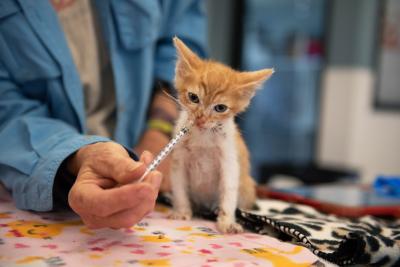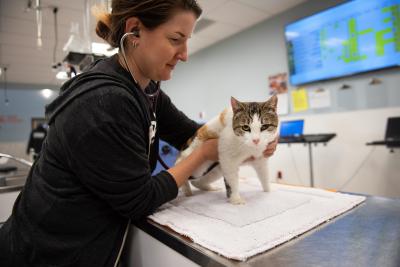Clinical trials aim to save cats from deadly FIP virus

Although he’s been gone for more than 13 years, Dr. Heather Kennedy still can’t think about Calvin without crying. The adorable Siamese kitten the veterinarian fostered one winter after he was found freezing in someone’s front yard is her one who got away. She got attached to the tiny kitten but had to make herself let him go to another home, rather than adopting him herself.
The depth of Heather’s sadness about Calvin isn’t because he went on to live a long, happy life with someone else. Although Calvin did get adopted to a family whose plan was to love him for life, he was only nine months old when he died of feline infectious peritonitis (FIP). He became one of many cats across the country to succumb to the virus because at the time, there was no known treatment for it.
“Anyone who has been in animal welfare for any length of time has run into FIP, and it’s the most heartbreaking, awful disease,” says Best Friends medical director Dr. Erin Katribe. “There is no effective vaccine, and untreated FIP is fatal 100% of the time.”
But recent research at the University of California, Davis (UC Davis) on two antiviral drugs might mean FIP no longer needs to be a death sentence. Best Friends is participating in the current clinical trials as well as sponsoring additional research to expand the number of cats who might benefit from treatment.
“It’s exciting to be able to participate in this research,” says Judah Battista, Best Friends chief sanctuary officer. “We will potentially save the lives of more cats in our care, for one. But we also hope to speed up access to successful treatment, thereby sparing more people from the heartbreak of losing a beloved member of the family to such a terrible disease.”

Clinical trials put two antivirals to the test
UC Davis professor emeritus Niels Pedersen has spent much of his career looking into FIP. He is also the one who first came upon an antiviral drug to treat it and subsequently published papers on its fantastic results in 2018 and 2019.
His findings have led to veterinary usage of the drug and a nearly identical second drug in the U.K. and Australia, where thousands of cats with FIP have been treated successfully. In the U.S., however, these drugs are still not available for veterinary use.
“As a veterinarian who works with shelters, to know that there is a drug out there that can cure cats with this illness and to not have access to it … that’s extremely frustrating,” says Erin. “But that’s where these clinical trials come in, and the fact that we are able to access such treatment for our cats and push the science forward is exciting.”
UC Davis is running several studies to compare the success rate of the two antivirals. Those that have been underway since August are for cats of all ages, but they must have the effusive form of the disease, commonly called “wet” FIP. Cats with wet FIP have an accumulation of fluid in their abdomen, which causes a swollen belly, or in the chest, which leads to difficulty breathing as the fluid puts pressure on the lungs.
[Cat purrs in the face of adversity]
There is a second type that is non-effusive, or “dry” FIP, and it causes subtler but no less deadly symptoms. In dry FIP cases, the cat’s inflammatory viral response impacts one or more organs, including the eyes, brain or liver. Symptoms can involve eye changes or neurological issues.
“UC Davis was not doing clinical trials on the dry form because it’s so much harder to diagnose with confidence and therefore harder to know for sure that cats have FIP,” says Amy Kohlbecker, director of Cat World at Best Friends. “But we periodically have cats who come down with and then die from this form, as does the public, so we worked with the school to create a trial specifically for dry FIP cats.”
The clinical trial for the dry form will be similar to the one for the wet form, and both will run for a four-month period. All enrolled cats will need to visit UC Davis’ veterinary medicine teaching hospital three times over the course of the trial, and Best Friends is working out the least-stressful logistics possible for cats to comply with that requirement.
Another major reason why Best Friends felt comfortable enrolling in these clinic trials is that there is no placebo group; every cat enrolled will receive some form of treatment. Additionally, UC Davis is only doing trials on cats with naturally acquired infections. That means they are not purposely infecting cats with FIP, nor are they euthanizing cats at the end of the trial period.
“We want to save cats, and we’re not interested in doing anything that would result in them dying just because they are part of a study,” Judah says.

Studies move cats one step closer to surviving FIP
While the American veterinary field waits eagerly for legal access to the antiviral FIP treatment, private individuals are accessing pricey drugs under the radar from unregulated overseas manufacturers. That shows just how desperate people are to save their cats.
“When the early studies showed how successful this antiviral treatment was, a lot of people said, ‘We’re going to go ahead and ship this in and make it possible for cats to stop dying,’” Heather says. “But it’s not cheap. Depending on the weight of the cat, it can cost as much as $10,000 to follow the recommended 12-week treatment period.”
Not only has the unregulated use led to exorbitant costs and legal issues, but there are medical risks as well. For example, there have been some reported cases of people receiving and treating their cats with fraudulent drugs. There are also issues around proper dosing, administration technique for the injectable version (which can be painful, though there are oral versions becoming more available) and the risk of complications.
[Blind, deaf kitten shows the meaning of resilience]
All of this makes it clear how important the UC Davis study is in seeking veterinary approval of the drugs through its clinical trials — and why it was important to decision makers at Best Friends to participate. An approved treatment could save thousands of cats from dying from FIP annually.
“It’s so very, very exciting to finally have an option for cats in our care who are affected by FIP,” Amy says. “Not to mention being able to contribute to the body of knowledge that will make this treatment more accessible to shelters and pet owners across the country — and of course to the cats themselves.”
Erin agrees. “As long as I’ve worked in veterinary medicine, a diagnosis of FIP has meant the cat will most likely die of the disease — and usually not long after the diagnosis is made,” she says. “For that not to be the case now? Who doesn’t want that?”

This article was originally published in the March/April 2023 issue of Best Friends magazine. Want more good news? Become a member and get stories like this six times a year.
You can save a life, too
Sign up to foster (and maybe even adopt) an animal near you.
Read more
Fearless kitten meets life’s challenges head-on
Tiny but mighty: a kitten’s journey
Four kittens survive a severe, contagious illness, thanks to incredible first-time foster mom
